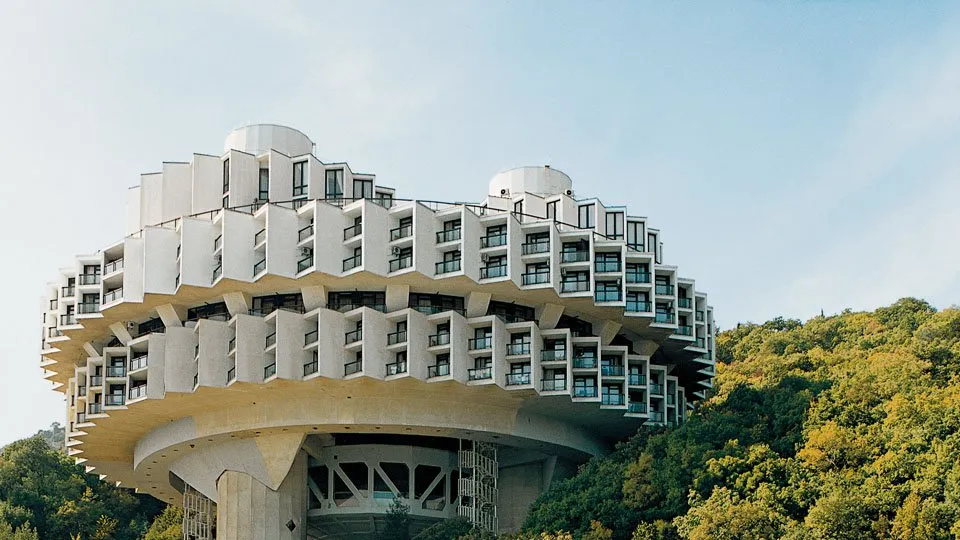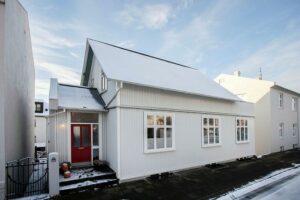It’s the mid-1970s, and as you walk through the streets of Moscow, you can’t help but notice the imposing structures that rise from the city’s landscape—monolithic buildings made of raw concrete with sharp angles and geometric shapes that defy traditional architectural norms. These aren’t the glittering palaces of the Tsars or the neoclassical masterpieces of earlier eras. No, these are the products of a new vision born from the Soviet Union’s industrial might and desire for functional, practical design: Brutalism. This architectural style, known for its rugged, unadorned surfaces and emphasis on function over form, quickly became synonymous with the Soviet Union’s urban planning during the Cold War. Today, these structures remain relics of a bygone era, but they inspire fascination and debate among architects and urban historians alike.
Brutalist architecture Russia, with its distinct Soviet influence, tells the story of a nation undergoing rapid modernization. The concrete blocks and towering structures that dominate cities like Moscow, Saint Petersburg, and beyond weren’t just buildings—they were statements, a physical manifestation of the USSR’s ideological and economic ambitions. Let’s explore the rise of Brutalist architecture in Russia, its defining features, notable buildings, and its lasting legacy on the country’s urban landscape.
The Origins of Brutalism in Russia
Brutalism as an architectural style emerged in post-war Europe, with architects like Le Corbusier championing raw materials, especially concrete, to create functional, austere designs. In the Soviet Union, however, Brutalism found a unique place in the country’s broader architectural evolution. By the late 1950s and early 1960s, after the death of Stalin and the subsequent rejection of Stalinist monumentalism, Soviet architects were tasked with rebuilding and modernizing the country to reflect its socialist ideals. The Khrushchyovka apartment blocks, simple and affordable prefabricated structures, dominated residential architecture during this period, but more significant civic and cultural buildings took on the Brutalist form.
In Russia, Brutalism was not only a design choice but also a necessity. The use of concrete—abundant, inexpensive, and easy to work with—aligned with the Soviet Union’s focus on functionality and mass production. The government encouraged the construction of buildings that could house large numbers of people or serve public functions while being cheap to construct and maintain. As a result, from the 1960s to the 1980s, Brutalism became the dominant architectural style for many public buildings, universities, and government offices across the Soviet Union.
Defining Features of Soviet Brutalism
While Soviet Brutalism shared many characteristics with its Western counterparts, it also had its distinct features. The most prominent feature, of course, was the use of exposed concrete. The structures were often massive in scale, with heavy, block-like forms that seemed to dominate the landscape around them. Soviet Brutalist buildings usually lacked ornamentation or decorative details, focusing instead on geometric shapes, clean lines, and an overall sense of functionality.
A key difference between Western and Soviet Brutalism, however, was the ideological underpinning. In the Soviet Union, Brutalist buildings were designed for utility and to embody the socialist ideals of equality and collectivism. The buildings were meant to serve the people—whether as housing, schools, or cultural centers—and their stark, utilitarian design reflected the government’s desire to distance itself from the bourgeois excesses of pre-revolutionary Russia.
In terms of scale, Soviet brutalist buildings were often aimed at monumentality, intended to impress upon citizens the power and permanence of the socialist state. Whether they succeeded in this goal is debated, but their size certainly impacted the urban landscape.
Notable Brutalist Structures in Russia
Several buildings stand out as iconic examples of Brutalist architecture in Russia, each with its own unique story and significance:
- The Russian Academy of Sciences (RAS) Headquarters
- Located in Moscow, the RAS headquarters, often referred to as the “Golden Brains” due to the golden structures perched atop the concrete towers, is one of the most recognizable Brutalist buildings in the city. Completed in 1990, it blends Brutalism with a touch of postmodernism. The building’s raw concrete façade and sharp angles are characteristic of the style, but its golden rooftop elements add a futuristic twist. Today, it is a landmark of Soviet-era architecture, and its design has sparked debate over its aesthetic value.
- The Palace of Pioneers
- Another essential Brutalist structure is the Palace of Pioneers in Moscow, built in the 1960s as a youth center. Its vast scale, geometric shapes, and expansive use of concrete embody the principles of Soviet Brutalism. It was designed to serve as a place for children to engage in educational and recreational activities, reflecting the Soviet Union’s commitment to nurturing its youth through state-sponsored programs. The building, with its long, horizontal lines and open spaces, exemplifies the Brutalist commitment to functionality and accommodating large groups.
- Hotel Salut
- Located in Moscow, the Hotel Salut is another striking example of Soviet Brutalism. Built-in 1979, the cylindrical structure is covered in concrete panels, with a repetitive, almost machine-like exterior. The hotel was intended to serve the influx of tourists and dignitaries visiting Moscow, particularly during events like the 1980 Summer Olympics. Today, the Hotel Salut remains an enduring symbol of Soviet-era architecture, and its distinctive design makes it a point of interest for fans of Brutalist architecture.
- Moscow State University Building
- While technically not fully Brutalist, the Moscow State University Building on Sparrow Hills, completed in 1953, incorporates elements of Brutalism within its Stalinist architectural style. Its towering presence and use of concrete make it a precursor to the full-scale Brutalist movement that would follow in the 1960s. As one of the most iconic buildings in Russia, it demonstrates the shift from decorative Stalinist architecture to the more austere and monumental designs of later decades.
Brutalism and Soviet Urban Planning
Brutalism wasn’t confined to Russia’s major cities—across the Soviet Union, from Ukraine to Kazakhstan, the style became a staple of urban planning. In fact, according to a report by the Moscow Urban Forum, approximately 70% of Soviet public buildings constructed between 1960 and 1980 followed Brutalist principles. This architectural style was seen in monumental civic buildings and the sprawling apartment complexes that housed millions of Soviet citizens.
The standardization of architecture and mass production of materials like concrete allowed the Soviet Union to construct vast numbers of buildings in a relatively short period. While these buildings were functional and affordable, they often needed more warmth and human scale than earlier architectural styles, leading to criticism in later years. However, for many, these structures remain a nostalgic reminder of the Soviet era.
The Decline of Brutalism in Post-Soviet Russia
With the fall of the Soviet Union in 1991, Brutalism fell out of favor in Russia, and many of these concrete giants were left abandoned or neglected. As the country transitioned to a more market-driven economy, newer architectural styles, often inspired by Western designs, took precedence. Glass skyscrapers and modern high-rises began to dominate cityscapes, especially in Moscow.
Despite this shift, there has been a recent revival of interest in Soviet Brutalism. Preservationists and architects alike have started advocating for the restoration and protection of these iconic buildings. According to Arch Daily, many architects and urban enthusiasts in Russia now see Brutalist structures as an essential part of the country’s architectural heritage. They argue that these buildings may not be conventionally beautiful, but they reflect a unique period in Russian history and should be preserved for future generations.
Conclusion: Brutalist Legacy in Russia
Brutalist architecture in Russia is a testament to the Soviet Union’s ambitious vision for its urban landscape. The towering concrete structures that once symbolized progress and power now evoke a sense of nostalgia, a reminder of an era when architecture was as much about ideology as it was about aesthetics. While many Brutalist buildings have fallen into disrepair, they continue to captivate architects, historians, and visitors alike, representing a complex and layered history that continues to shape Russia’s cities.






